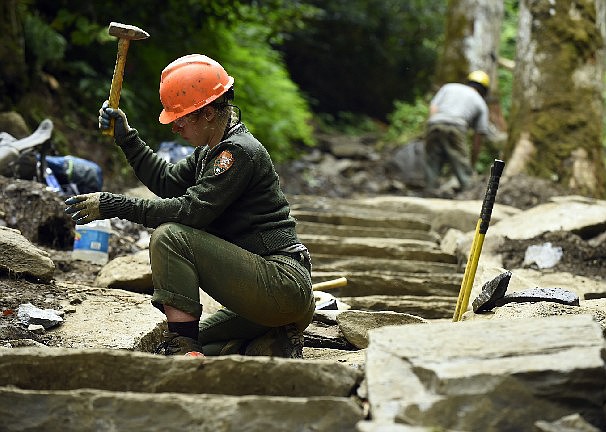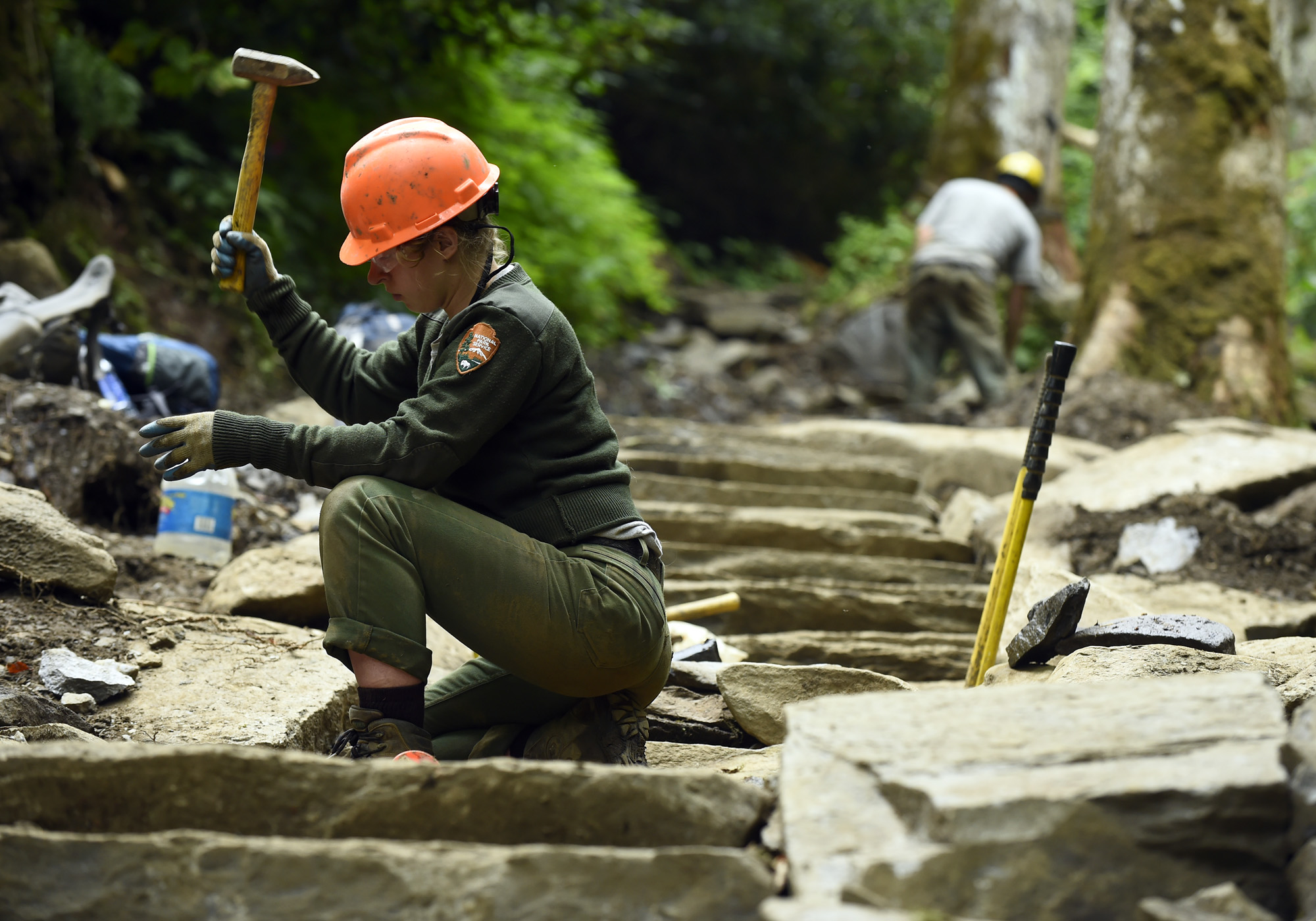GATLINBURG, Tenn. - While some crew members pounded rock into gravel with sledgehammers, others used pry bars to skid granite boulders into place. A hand-powered cable winch capable of pulling 4,000 pounds was strapped to a buckeye tree at the top of a steep flight of steps, and everyone was covered in mud.
The crew was 1 1/2 miles up the Chimney Tops Trail, one of the rockiest, steepest and most popular hiking trails in the Great Smoky Mountains National Park. Three years ago, with funding from Trails Forever, they began working their way up the mountain from the trailhead off U.S. Highway 441, also known as Newfound Gap Road.
Now, they're only a half-mile from the double-capstone knob famously known as Chimney Tops, and barring any unforeseen delays, they expect to finish by mid-October.
"We're trying to build a trail that will last 100 years," said Tim Warner, trails specialist for the Smokies. "There's not a medium we're not using, whether it's dirt, locust logs or rock. There's thought that goes into every inch."
Launched in 2009 during the Smokies' 75th anniversary, the Trails Forever program provides dedicated funding to address the park's most heavily damaged hiking trails. To create the endowment, the Friends of the Smokies raised $2 million that was matched dollar-for-dollar by the Aslan Foundation. The $200,000 in annual interest from the endowment pays for a special trail crew that focuses on trail reconstruction as opposed to the routine trail maintenance handled by the park's other two crews.
Not since the days of the Civilian Conservation Corps have trails in the Smokies undergone such basic reconstruction.
The park's first Trails Forever Project was the Forney Ridge Trail that lasted from 2010 to 2011. The second project is the Chimney Tops Trail that began in 2012. Like Forney Ridge, the Chimney Tops Trail was badly eroded. Ascending 1,400 feet in just two miles, the trail was a boulder-strewn mess with long muddy sections that encouraged hikers to look for dry ground wherever they could find it. Parts of the trail were worn down to exposed bedrock; after a hard rain, hiking the steep, narrow sections was like rock hopping a mountain stream.
Trail crews since 2012 have controlled the runoff with drainage ditches, waterbars and elevated turnpikes -- two-sided structures that use fill material to build up the trail base so it's higher than the water table. In some places, crews recontoured the trail to give it a gentle side slope for shedding water.
But the most eye-catching improvements are the long flights of steps that meld into the mountain like natural outcroppings. Some of the steps are constructed of rot-resistant locust logs that were flown in by helicopter. Others are made of stone dug up at the site. To split large rocks, wedges and shims are placed in holes bored into the rock by a gas-generator-powered drill. Hitting the wedges eventually causes the rock to break along the score line. Once the step is in place, gravel pounded at the site is stuffed under and around the step for stabilization. All the stones are dry-stacked, and setting a single step can take almost a full day.
Last week the park's Trails Forever team was assisted by a crew from American Conservation Experience based in Asheville. The project also receives support from the Student Conservation Association as well as local volunteers. The trail is open on weekends, but closed to the public Monday through Thursday when workers are on site.
Josh Shapiro and Eric Wood are the park's crew leader and assistant crew leader for the Chimney Tops Trail project. They both honed their chops on the Forney Ridge Trail, where they learned to approach stone work as an improvisational art.
"Working with stone can be the most frustrating thing in the world, or the most gratifying," Shapiro said. "You have to have an eye for it. There's a lot of trial and error."
"We're out here beating on rocks with hammers -- it's almost prehistoric," Wood added. "This is such a cool project. Sometimes when I get home, I can't stop thinking about it at night."

